|
- Catalog (in stock)
- Back-Catalog
- Mail Order
- Online Order
- Sounds
- Instruments
- Projects
- History Face
- ten years 87-97
- Review Face
- our friends
- Albis Face
- Albis - Photos
- Albis Work
- Links
- Home
- Contact
- Profil YouTube
- Overton Network
P & C December 1998
- Face Music / Albi
- last update 03-2016
|
The dance performance with masks is a pantomime mystery play, and for this reason these performances are part of ceremonous services held by Buddhists. The word is of Tibetian origin and means "dance".
Historical development of the performances
In Tibet there have always been performed mystery plays and cult dances since time immemorial on; on these occasions, magnificent masks have been worn. On the occasion of certain religious holidays of the year such a masque is presented. Apart from this, there are also magic ceremonies (Tantrism) making use of masks, too.
The performance is supposed to be a relic from century-old rites of fertility and banishment. As far as it is possible to have a survey on early Tibetian traditions, dance performances were given on the occasion of festivities celebrating New Year and spring as well as on the occasion of midsummer festivities. In Bontum the New Year dances were seen as a symbol of the successful fight of good against evil as well as an illustration of the soon-to-come victory of spring over the dark forces, the lords of the long Tibetian winter. A very long time ago human beings and animals were sacrificed at New Year, in order to please the spirits and demons and to guarantee their favour for the days of the year to come. The followers of the Bon religion called the old Tibetian mystery play "the Dance of the Red Tiger".
In the works of Agwangchädub (a scholar and head of the monk community) there is stipulated that these masques have their origin in India where in older times special actors (in part professional actors) with masks and in the costumes of the gods and demons danced and performed dialogues.
The Indian Padmasambhava, a Buddhist teacher of religion and mystic, founded the monastery Samye in Tibet (770 A. C.). By means of the performances of the "holy dance of the masks", the mythical dance of the dreadful deities, he then tried to persuade the Pagan deities and spirits, the local lords, otherwise, so as to not harm the founders of the monastery. This was the first time dance performances took place in Tibet. In this way, the purpose of the old mystery plays was transformed into a new purpose of its own. In former times these dance performances represented the victory of light over darkness, which, however, then was turned into the triumph, the victory of Lamaism over the Pagan world of the Bon religion.
At the end of the 14th century the protest of the monk Tsongkhapa against the loose morals of the Tibetian monks led to a schism of the church. Tsongkhapa became a reformator and founded the "Sect of Virtue" ("Yellow Church", known as members wearing yellow caps), and he introduced the colour yellow for the habit of the religious order. The followers of the new church also adopted the dance performances. The original dance performance of the masks, the "tsam" as it is called nowadays, was introduced by this religious order only in the 16th century when, for the first time being, "tsam performances" took place in the monastery of the Pantschen-Lama, Taschilhumbo, in Tibet.
The Mongolian population is Lamaistic, and, for this reason, they also know tsam performances. This was also the area in which the yellow church spread. In the Mongolian monasteries Buddhist art had rather sophisticatedly developed before their destruction in the 1930ies. And among these painters, sculptors, and architects as well as skilled craftsmen, there could even be found some real masters of their art.
In the Mongolian area, the first tsam performance was given in the monastery which served as residence for Chutuktu of Urga (today Ulaanbaatar), an incarnation of the Tibetian saint Taranatha; this took place in the 16th year of the reign of the Manchurian emperor Djia-tjing (1811). Mongolian masters fabricated the costumes and masks following the description given in the work by the V. Dalai Lama on the "tsam".
On the basis of the dialogues that make up part of the dance performance, the so-called speech tsam (only the funny and human roles were allowed to speak), there was taking place a transition from the pure cult action to the form of the theatre. And the performances ceased to represent only deities and demons but rather also human beings. The dancers, in addition, were not merely monks anymore but also laymen. In this connection, there is to be made special reference to the Milaraspa dance performance (Mongolian: Milaräba Tsam).
Tsam performances in Mongolia
Milaraspa-Tsam
This "tsam" (Mongolian: Milaräba) is named after the Tibetian hermit "Mila". It is based on legends telling from the life of the famous poet and recluse of the "Red Church", "Mila with the Cotton Cloth". The tsam contains dialogues for actors, which were also put down in writing in hand-written textbooks. The best known of these textbooks is called "Dance of the Protector of the Thunderbolt".
Geser-Tsam
The God of War Geser was considered to be the partron saint of the family of the Manchurian Emperor, of the warriors and herds. He guaranteed good luck for the hunt; he was the destructor of enemies and demons. He is also called "Son of Heaven".
Well-known performances of the Geser Tsam:
- In the West, in the monastery of the holy Chutuktu Ulaguksan and in the vasall monastery of the ruler Dalai Tschoinchor-wan; these two monasteries, situated in Northern Mongolia, now the People's Republic of Mongolia, also contained a faculty for studying mystics.
- In Eastern Mongolia in the monastery of the ruler Sansaraidordschi in today's city of Tschoibalsan (Bajan-Tumen) in Eastern Aimak of today's People's Republic of Mongolia; this monastery even included a Geser temple.
The Dschagchar-Tsam - Erlik-Tsam
This is the "Dance of the Iron Palace". The main role in this tsam is Erlik Nomun Khan, the Lord of the Law, also known as Tshoijoo (God of Death). This is an old Mongolian name for the God of Death, which was used for Yama by the shamans in translations of Buddhist texts.
Music
While performing the tsam, the musicians get into two lines, one behind the other. The tambourines and drummers are seated in the front row. Behind them, there are seated the wind section setting the tone as well as the cymbalists.
- see more about Instruments
Mask costumes - Boots
The mask costumes are very colourful and decorated with numerous embroidered ornaments. The costumes of the deity masks are fabricated from expensive cloths, mainly from brocade or atlas silk, whereas the fabrics for the costumes of the other masks are made from wool or cotton. The design of the masque costumes is rather unique. The sleeves are tapered to produce a tip, and they are cut rather loose in order to keep therein arms and other objects. The large collars (capes - called Modig) fall loose, reaching beyond the shoulders. Colourful applications or embroidery with religious symbols are put in the middle of the broad aprons (Dodig). The major masks wear a decorative cape (Ruujin) over the whole costume, which consists of about eight pearl strings made from human or animal bones. In Mongolia there can also be found Ruujin made from ivory. The joints are decorated with Buddhist symbols.
Even the boots are decorated with heads of sea monsters (Makara). These are meant to put off demons, and while dancing, the dancers try to crush their bodies by means of predetermined steps. The sole of the foot is pulled to the front top in order to not damage the soil while kicking and crushing the spirits.
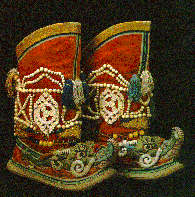 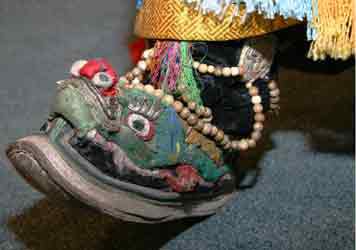
Boots
Masks
The larger-than-life masks of the deities are put over the head, and they cover the whole of the face. The masks representing human beings are only facemasks of natural size.
For the production of these masks, a mass made from papier-mâché (also in Mongolia) as well as a thin and embossed copper sheet are used. In areas with larger wood resources than in the Tibetian uplands, such as in Sikkim and Bhutan, the masks are also carved from hard wood. There the humid climate would quickly destroy the paper mass. The people from Tuva, on the other side, fabricate their masks from leather.
- see more about Fabrication of Masks
- see more about Dance Masks
The mask is very often combined with a wig made from the hair of yak tails. The masks are usually colourfully painted.
The colouration of mask and costume follows old tradition and is identical with Lamaistic iconography.
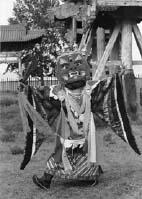 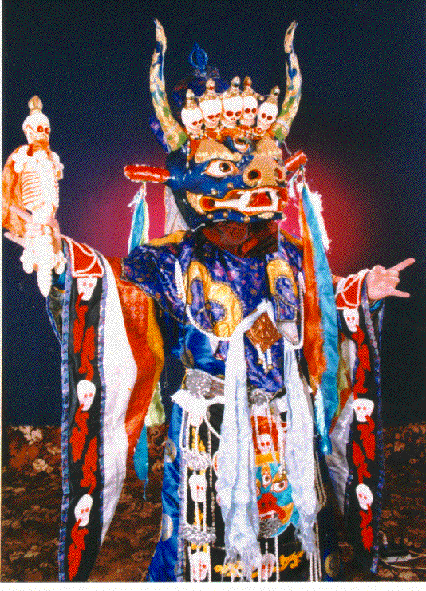
Dharmapala "Jamsran" - Yama "Tshoijoo"
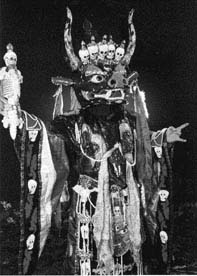 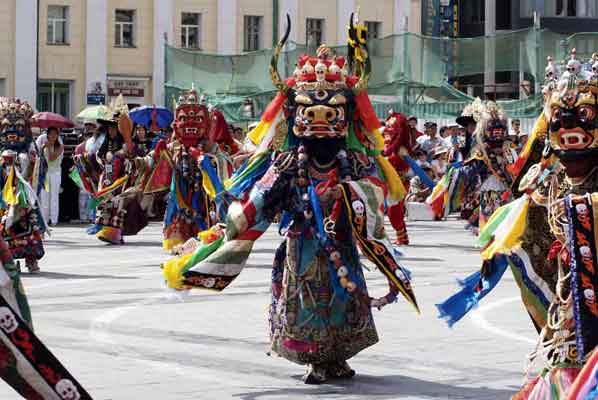
Yama "Tshoijoo"
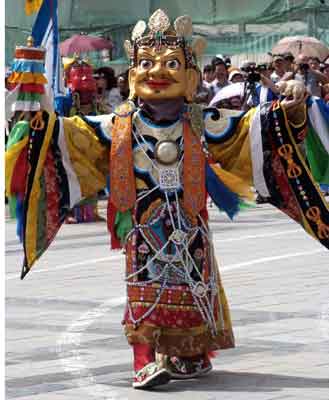  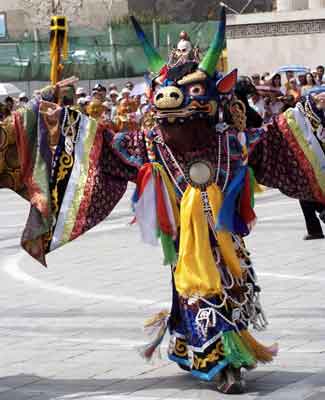
Namsrai - Zamindi - Makhi
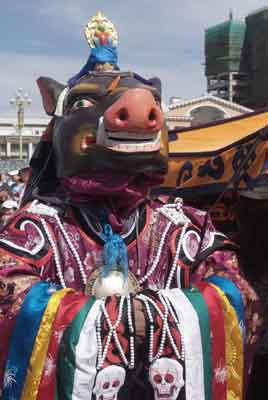 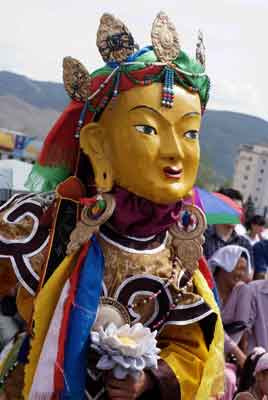
Wild Boar - Tshokdshong
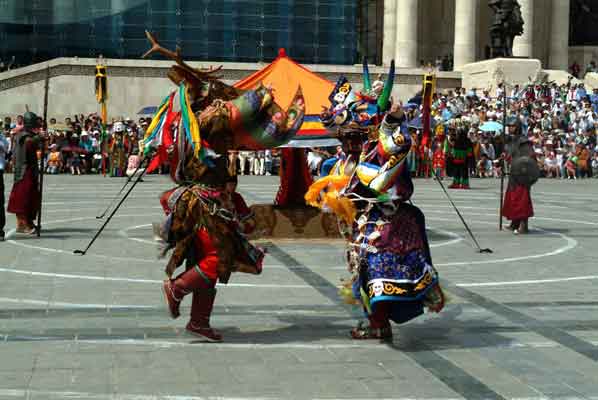
Shiva - Makhi
The Old White Man
The Mongolians worship the Old Man. Originally, he was the progenitor of the individual families. He is also considered the protector of the herds and the giver of the harvest. This figure may also be found in many Asian areas. He is a God of Fertility and also the symbol of a long life. Christian Burjates consider him the Holy Nikolaus, for the Shamans he is Pan, the Spirit of Earth. In the tsam he plays the role of a clown like the Chinese monk Hoschang with his children, and he distributes sweets.
 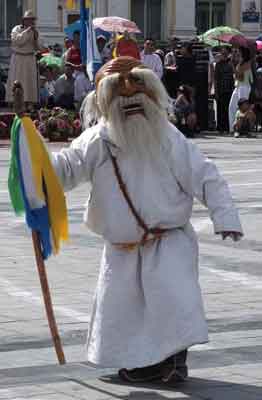
Old White Man
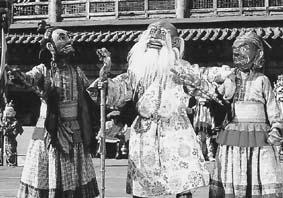
Old White Man with Atsaras
|
